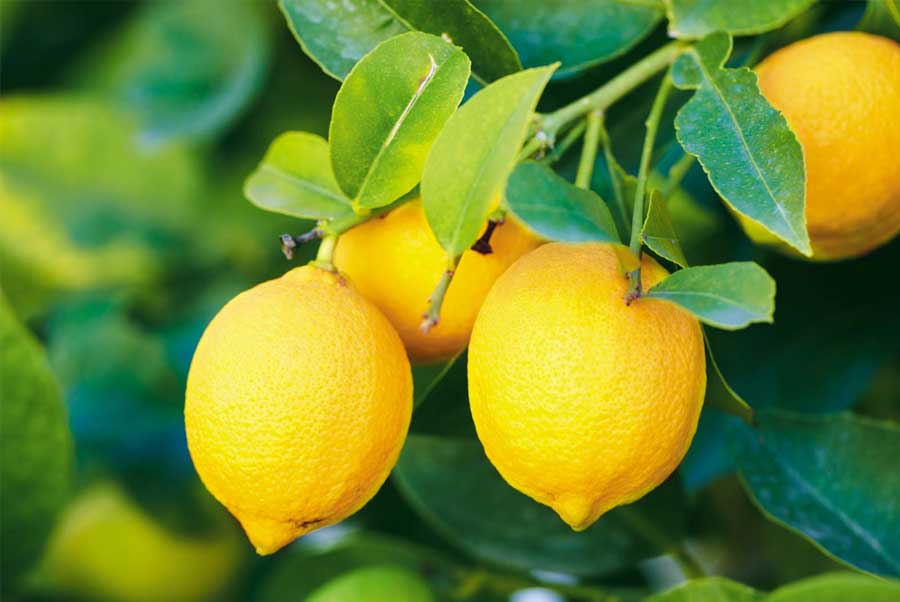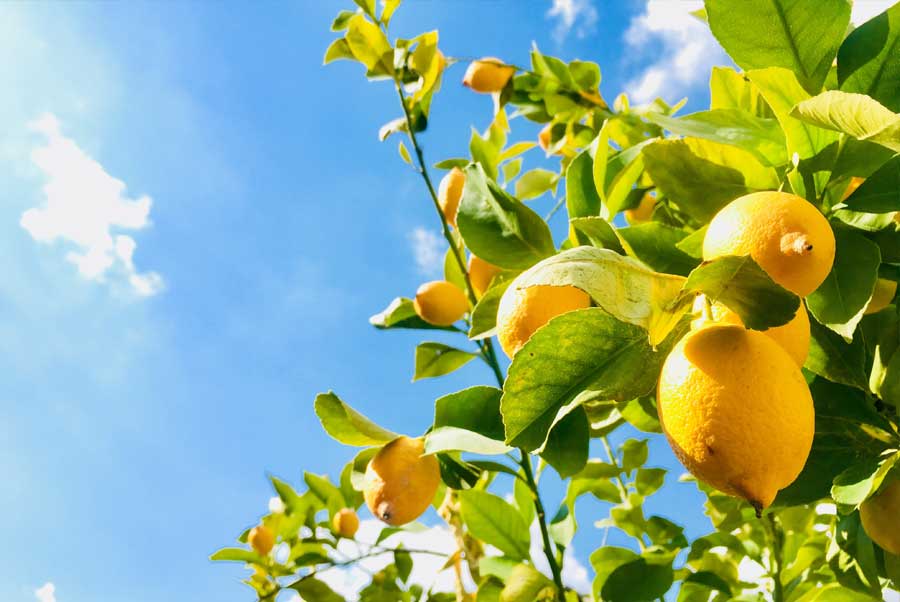The most common lemon varieties are Eureka, Lisbon and Meyer. Eureka produces its main crop in winter with smaller crops in spring and summer. Eureka lemons have relatively few seeds and the tree is virtually thornless growing to around four metres in height.
Lisbon is thornier and produces its main crop in winter, however is tends to be more cold tolerant. It grows around three to four metres tall.
Meyers has a milder, less acidic flavour with a smooth, thin rind. It’s main crop is produced in winter but it can crop continuously throughout the year. It’s a small tree growing to around two metres in height, making it the ideal lemon tree to grow in a pot.
Preferred climate depends on the variety of lemon, however most do well in warm climates. They tolerate drought and are sensitive to frost.
Lemon trees require a position in full sunlight that is protected from winds and frost. If you’re growing a lemon tree in a cooler climate, plant it close to a brick wall so it can utilise the radiating heat.
Lemon trees can tolerate a range of different soils but they mostly prefer slightly acidic, well-drained soil.
You can plant lemon trees at any time of year in warmer climates, as long as you water regularly. In cold regions plant in spring to protect it from late frosts.
Citrus will thrive in large containers. Choose a pot with a diameter of 50cm or more, with plenty of drainage holes, and fill with a premium quality potting mix. Place your potted citrus in a sunny place in the garden, and make sure the plant is kept moist at all times. You will need to feed with a Citrus Fertiliser regularly.
It’s a great idea to stand your pot on a trolley so you can easily move the pot to a sunnier or more protected position with the changing seasons.
If you’re planting a lemon tree in the garden, start by digging a planting hole twice a wide and as deep as pot your citrus comes in. Remove the pot and inspect the roots. Untangle any that appear to be circling around or those that are tightly packed into the shape of the pot. Plant so that the original soil level in the pot is level with your garden soil. Backfill the hole with the removed crumbled soil, and work compost or well-rotted cow manure into the top 10cm of soil. Add a mulch of straw to the soil surface, but keep this away from the trunk.

Water immediately after planting and from then on keep the soil slightly moist.
Lemons grow best in soils that are moist but not soggy. Water your tree every seven to 10 days during the summer, providing it with 4 to 6 inches of water each month. Allow the soil around mature trees to partially dry between waterings. Overwatered lemon trees may suffer from crown and root rots, while those not watered enough frequently shed blossoms and don’t produce as much fruit.
Citrus produce loads of fruit! All that flowering and fruiting is a big consumer of energy so make sure you feed up your lemon tree to ensure further crops. You will tell if your tree is undernourished by poor stunted growth, or yellowing leaves. Feed twice a year with a citrus food, once in February and again in August. Follow the directions on the packet and water the soil well both before and after apply the fertiliser.
Pruning lemon trees is important for growing healthier and more plentiful fruit.
It’s best to prune your lemon tree from late winter to early spring, right after harvest. Young trees should be pruned to establish a good shape, remove any sprouts or weak limbs so the plant can focus on growing a strong canopy.
As the tree grows, prune any crossing limbs, tangled branches or dead wood. Main scaffold branches should be staggered, aim to maintain eight once the plant is established. Prune subsidiary shoots off these scaffold branches. Aim to prune 20 percent of the canopy each year, focusing on longer, protruding branches that affect the desired shape of the canopy. Thinning out of branches as trees age allows light to penetrate more areas of the tree encouraging fruit production inside the canopy as well.
Skirting is also essential, this process involves pruning the branches and limbs that hang down to the ground as this allows for better air movement under the trees and reduces fungal problems and insect infestations. Prune this low growth to lift the ‘skirt’ to around one metre high.
Lemon trees generally take around two to three years to bear fruit and harvesting depends on the variety of plant. Eureka’s produce fruit two to three time a year while Lisbon’s fruit once a year.
Lemons are ready to harvest when they have developed full colour and flavour. Harvest lemons when their peels are yellow or only a green tinge, with a slightly glossy appearance. The longer the fruit stays on the tree the sweeter it will become so some suggest picking and tasting your fruit to determine how the crop is developing.
To pick lemons, use the twist, tilt and snap method. Take the the entire fruit in your hand and twist it gently, tilting and pulling away until it breaks free.
To propagate a lemon tree it’s best to a cutting in late spring, early summer. Choose a 15 centimetre piece of a healthy young branch without fruit or flowers and at least two to three nodes at the base. Us a non-serrated, sanitised knife to cut the stem at a 90-degree angle. Wrap cuttings in a moist paper towel to prevent dehydration.
Remove bottom leaves so the cutting has only three or so leaves at the top and dust the bottom with a hormone-based rooting powder. Plant the cutting in a large, well-draining pot with seed starter mix and cover it with a large clear plastic bag to create a warm, humid environment. Use chopsticks, wire or dowel to keep the bag from resting on the cutting. Keep the soil moist
Once roots develop, remove the plastic covering. After a few days move the cutting outside in a sheltered location. Once the roots of the plant nearly fill its pot its time to plant it in a larger pot or garden.













